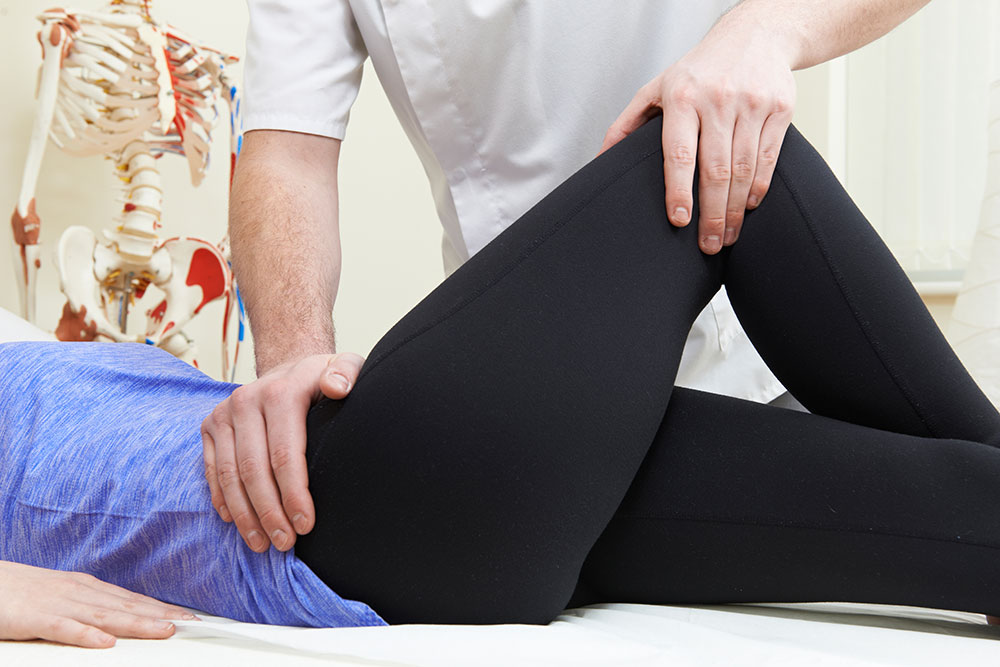Hip Replacement
As the name suggests, hip replacement surgery replaces the worn out hip joint with a prosthetic (artificial) joint. Total hip replacement, although dating back to the 1940’s, was advanced in the UK in the 1950’s and 60’s by Sir John Charnley. Today, over 55,000 total hip replacements are performed in the UK each year. There are now many different types of hip replacement available. The most widely used consist of a metal ball articulating with a plastic socket. Some hip replacements are designed to be used with orthopaedic cement, which acts as a grout; others are designed to encourage bone growth onto the prosthesis to give long term stability (uncemented).
It is the plastic liner that wears out with time, probably related to activity levels. Technological advances, however, have produced bearing surfaces which can withstand higher activity levels and will therefore wear out more slowly. These newer bearing surfaces are either metal-on-metal or ceramic-on-ceramic. Patients who are young and physically active may benefit from these newer hip replacements since the risk of implant failure is reduced.
WHAT ARE THE BENEFITS OF HIP REPLACEMENT?
The majority of patients experience the following benefits following hip replacement:
Abolition or at least a significant reduction in hip pain
Improvement in life quality
Return to normal daily activities and low impact sports
Sleeping without pain
Improvement in leg strength as a result of a return to more normal
levels of activity
Years of reliable function
THE PROCEDURE
Patients are usually required to attend a Pre-admission Clinic a couple of weeks before the proposed operation date; investigations will be undertaken and the operation discussed.
Hip replacement surgery involves an inpatient stay of 3-5 days; the patient will generally be admitted the day before the operation. The consultant and anaesthetist will see the patient prior to surgery and the hip undergoing the replacement will be marked.
Most hip replacements are performed under a spinal anaesthetic (where the patient is awake but normally sedated), but occasionally a general anaesthetic is used. The hip is dislocated so that the damaged femoral head can be removed and replaced with a femoral component (the ball), the stem of which is inserted down the centre of the thighbone. The damaged acetabulum of the pelvis is shaped so that the new prosthetic socket can be inserted.
At the end of the operation a dressing is applied to the wound. Foot pumps, elastic stockings and occasionally an injection to thin the blood are used to lower the risk of blood clots forming in the legs.
Post-operative pain is normal after a hip replacement. It can be controlled by many methods, from pain pumps (Patient Controlled Analgesia, PCA) to simple tablets, and usually lessens dramatically after the first 2-3 days. The pain of arthritis usually disappears within a day or two of surgery.
Occasionally, the bladder stops working after a spinal anaesthetic; a catheter may need to be inserted into the bladder for a day or two. Once removed, most people have normal return of bladder function.
Blood tests and X-rays will be taken in the early post-operative period to ensure that blood levels have not substantially changed and that the hip replacement is in a satisfactory position.
The physiotherapists will assist patients in mobilising after the operation and will supervise an exercise programme. It is extremely important that patients follow this exercise programme and take the necessary precautions with their new hip.
Patients can usually return to work after 8-12 weeks although this period may be longer for heavy manual work. By three months most patients can participate in low impact sports such as golf, bowls, cycling and swimming.
The majority of patients undergoing hip replacement do not experience any complications. In fact 95-98% of patients are extremely happy with their hip replacement and report that it has given them back their life. However no operation can guarantee success.
Complications can occur as a result of the anaesthetic, the hip replacement itself or as a general result of having major surgery:
Infection
The risk of infection after hip replacement
is about 1%. The majority of infections are
superficial and require nothing more than
antibiotics. Occasionally, however, further
surgery is required to deal with infection,
and rarely the hip replacement needs to be
removed until the infection is under
control.
Antibiotics are used in every hip replacement and the operation is performed under sterile conditions.
Deep vein thrombosis (DVT) and Pulmonary
embolus (PE)
Blood clots can form in the veins (DVT),
break off and travel around the bloodstream
and lodge in the lungs (PE). This can be
life threatening, but the risk is very low.
Measures that are taken to reduce the risk of DVT and PE are the use of foot pumps and elastic stockings, blood thinning injections and early mobilisation.
Dislocation
Since an artificial hip joint is not as
stable as your own original joint there is a
risk that it may dislocate; the risk is
approximately 2%. The hip is most unstable
during the first 6-12 weeks; after this
dislocation is rare.
Leg length inequality
In some cases the leg length must be
lengthened in order to stabilise the hip and
thereby reduce the risk of dislocation. It
is very difficult to ensure a resulting
equal leg length during hip replacement
surgery, but most patients (80%) do not
notice any great difference after their
operation. Any minor leg length discrepancy
can be treated with a heel raise.
Nerve damage
Occasionally one of the nerves supplying the
leg is stretched and does not function
properly for a period of time. The most
common effect of this is to cause a foot
drop. Over 90% of these nerve injuries
recover on their own without the need for
further surgery.
Wear
95% of modern conventional hip replacements
will last for 10-15 years. Technological
advances, however, have produced bearing
surfaces such as metal-on-metal or
ceramic-on-ceramic which can withstand
higher activity levels and will probably
last much longer.
When the hip replacement wears out, small wear particles are produced which can eventually cause the hip replacement to become loose and painful. In this situation, the hip replacement may need to be revised. (See Revision Hip Replacement)
For more information on hip replacement surgery please do not hesitate to get in touch with Mr Atwal through our appointments page.



QUICK ENQUIRY


